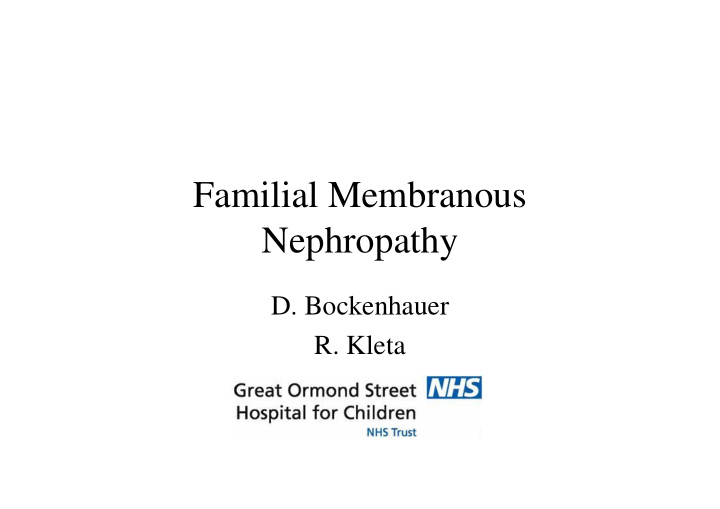



Familial Membranous Nephropathy D. Bockenhauer R. Kleta
Gene identification • Positional cloning: Independent of conventional clinical concepts • Reveal pathophysiology • Identify treatment targets
Index patient: (903017) • Presented at 1 y of age with nephrotic syndrome, microscopic haematuria and hypertension • No improvement with prednisolone treatment • Renal biopsy
Family History 90302 90309 90311 90317 All affected male and connected through maternal line =>X-linked recessive inheritance
Family History • Uncles 90309 and 90311 presented at ages 3 and 10 year, respectively, with nephrotic syndrome • Both experienced progressive kidney failure; one in CKD IV, the other transplanted (no recurrence) • Great-uncle 90302 presented age 67 with cholecystitis, noted to have nephrotic range proteinuria (16.6g/24h) and CKD III • Biopsies consistent with membranous nephropathy
Conclusions-1 • Family with 4 male members affected with primary MN • Incidence of nephrotic syndrome in childhood due to MN is ~1:10 6 • Incidence of MN in adulthood ~ 1:10 5 • Therefore, likelihood of all 4 members affected just by chance is 1:10 23 • An underlying genetic basis must be assumed • Inheritance pattern consistent with X-linked recessive
Assessment of further family members
Genetic Analysis
Conclusions-2 • There is a small segment on the X-chromosome potentially shared by all affected members • Regions potentially shared also by unaffected members, consistent with decreased penetrance => “susceptibility” factor for MN • May also explain variable age of onset • 70% of patients with primary MN are male • X-linked factor may explain sporadic cases • Potential therapeutic target
Acknowledgements • Family for collaboration • Halpin foundation • Drs Debiec and Ronco
Recommend
More recommend